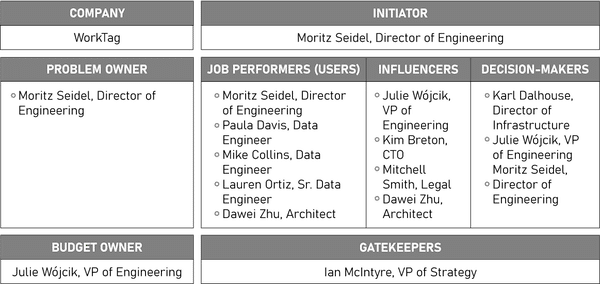Selling in mid- to large-sized businesses is never as straightforward as selling to small businesses.
Closing a sale with large organizations often means convincing a group of stakeholders–the decision-making unit or “Jury” in the terminology of The MIT Entrepreneurship Center–to fire their existing solution, and reassign their budget to your solution.
Driving a sale through means understanding the needs and concerns of the influencers of the Jury, from the Economic Buyer to the Technical Buyer, all the way to the User Buyer, the person most concerned with the user experience (UX) and day-to-day impact of your solution.
In this article, we take a look at the role and influence of the user buyer on the buying process.
The Role of the User Buyer in B2B
User buyers–sometimes called end users, Job executors, or Job performers–are the people who are using or supervising the use of a product inside an organization.
User buyers generally care about how a specific product will be used on the day to day, its impact on their work, and who else will be affected in the company.
They’re concerned with the quality of the user experience. They might want to understand how specific situations will be handled—and how the solution will make their work easier, make them look good to their managers, and set themselves up for career progress.
To user buyers, there’s a direct relationship between their success and your solution’s success. To that effect, they may be asking questions about specific features, processes, or use cases.
They might also be doing their own research, or consulting with peers in user groups or communities to see what other organizations that have implemented your solution are saying about it.
With the growing consumerization of enterprise software, more teams controlling their budgets and the choice of the products they use, and the growing importance of UX at work, the influence of user buyers on the buying journey is bound to grow over time.
How to Sell to the User Buyer
User buyers can help you learn how to best deliver value in their companies.
There may be several user buyers, and they may be spread across different teams or business units.
It’s important to speak to them to understand how to drive real results for their organizations.
Since they often don’t have their own budget, you’ll want to focus your interactions on learning, building relationships, and convincing them to introduce you to other buyers.
Expect resistance as user buyers generally won’t agree to connect you to the other buyers unless they’re sure that your solution will add value to their work.
Focus on the personal benefits–how your solution will make their work better, and make them look good–and make sure they’re feeling heard and understood.
You can map the buyers (user buyer, economic buyer, etc), organization by organization, using a table like the following:

Start Mapping Your Buying Influencers – Get the Printable Buyer Map for Free
More on Buyers and Users
- How to Map the Needs of the Decision-Making Unit (DMU) in B2B Sales
- The Role of the Economic Buyer in B2B Sales & Customer Development
- The Role of the Technical Buyer in B2B Customer Development
Download the First 4 Chapters Free
Learn the major differences between B2B and B2C customer development, how to think about business ideas, and how to assess a venture’s risk in this 70-page sampler.
Working on a B2B Startup?
Learn B2B customer development with our free email course:


